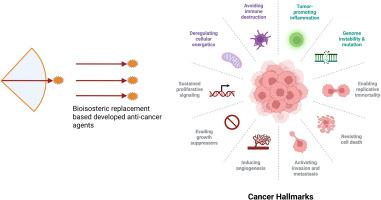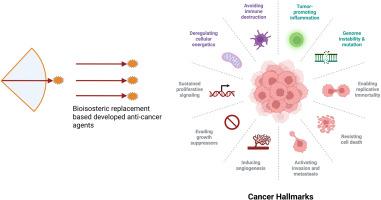生物同位:一种开发新型抗癌药物的方法
IF 5.9
2区 医学
Q1 CHEMISTRY, MEDICINAL
引用次数: 0
摘要
生物同位性是开发新型药物分子的有力策略。这种方法允许研究人员通过用相似的电子或结构部分替换分子支架上的官能团或原子来合理地设计药物分子,以微调其生物活性。因此,结构性质的改变增强了药理学性质,如选择性、结合亲和力、代谢稳定性和药代动力学,同时毒性最小化。在癌症中,特别是在耐药肿瘤中,它们对大多数化疗药物和靶向药物变得耐受,这是治疗中的瓶颈。因此,利用其生物同体改变分子上现有的药效特征有助于提高选择性,降低耐药性和毒性。在本文中,我们主要收集和整理了各种经典和非经典的生物等构替代策略,正在考虑开发一种新的抗癌药物。在这里,我们还强调和讨论了一些生物学途径,这些途径可以进一步用于了解疾病的生物学,以设计和优化主要候选药物。综上所述,本文将对那些不断致力于优化现有分子或药物以开发下一代癌症治疗方法的研究人员有所帮助。本文章由计算机程序翻译,如有差异,请以英文原文为准。


Bioisosterism: an approach to develop new anti-cancer agents
Bioisosterism is a powerful strategy to develop novel drug molecules. This approach allows researchers to rationally design a drug molecule by replacing functional groups or atoms on a molecular scaffold with similar electronic or structural moieties to fine tune its biological activity. Thus, change in the structural properties enhances pharmacological properties such as selectivity, its binding affinity, metabolic stability and pharmacokinetics with minimized toxicity. In cancers, especially those that develop drug resistance become tolerant to most of the chemotherapeutics and targeted medications which is a bottle neck in the treatment. Thereby altering the existing pharmacophoric features of the molecule with its bioisosters can help in enhancing the selectivity, reducing the resistance and toxicity. In this review, we were mainly focused on collecting and compiling various classical and non-classical bioisosteric replacement strategies being considered to develop a new anticancer agent. Here we also emphasize and discuss some biological pathways that could be further utilized to understand the biology of the disease and to design and optimize a lead candidate. Overall, this review will be helpful for those researchers who are continuously involved in optimizing the existing molecules or drugs to develop next-generation therapeutics for cancer treatment.
求助全文
通过发布文献求助,成功后即可免费获取论文全文。
去求助
来源期刊
CiteScore
11.70
自引率
9.00%
发文量
863
审稿时长
29 days
期刊介绍:
The European Journal of Medicinal Chemistry is a global journal that publishes studies on all aspects of medicinal chemistry. It provides a medium for publication of original papers and also welcomes critical review papers.
A typical paper would report on the organic synthesis, characterization and pharmacological evaluation of compounds. Other topics of interest are drug design, QSAR, molecular modeling, drug-receptor interactions, molecular aspects of drug metabolism, prodrug synthesis and drug targeting. The journal expects manuscripts to present the rational for a study, provide insight into the design of compounds or understanding of mechanism, or clarify the targets.

 求助内容:
求助内容: 应助结果提醒方式:
应助结果提醒方式:


